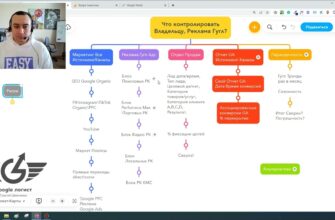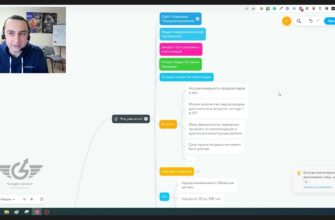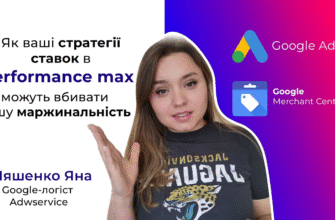- What is SKAG: 1 group – 1 key?
- SKAG benefits:
- 1. The ability to get the highest possible CTR
- 2. Flexible bid management
- 3. Easy to train the system and learn yourself
- Disadvantages of single-keyword ad groups:
- 1. For some specialists, it is too laborious to accompany
- 2. Slowly testing new versions of changes or experiments.
- 3. Reduced optimization score due to the fact that there are too few requests for low-frequency keywords.
- Will single-keyword ad groups be relevant in 2020?
- GOOGLE AD SALES FUNNEL
- AWARENESS stage:
- Next stage of interest:
- So, we are moving on to the learning stage:
- Next, we proceed to the stage of comparing analogues:
- And the final chord:
- How to structure them later?
Hello. My name is Yana Lyashenko and I am a Google Logistician. I am engaged in the delivery of TRAFFIC to a business with the necessary parameters.
Today I will tell you something that is not discussed either in courses or at conferences. Even Google itself is silent about this.
What if I told you that by rearranging your ad structure, you could get x2 sales or more? The correct structure of your advertising depends on the cost of advertising Google ads, and the amount of sales received.
Let’s start from the beginning. What is a structure? This is a grouping of your advertising campaigns and keywords. From the height of 6 years of experience in advertising and optimizing hundreds of advertising campaigns, I can say that the best grouping is SKAG (1 ad group – 1 keyword). And yes, now stones will be thrown at me from some specialists, who will start “futing” on this structure, splashing with saliva. But if you have a systematic approach to advertising or you work with the bourgeoisie, I have not yet seen better organized structures like SKAG.
How many calls and sales will I get by ordering contextual advertising from you?
I need to calculate the conversion of my website Describe
the task
in the application
Calculate potential ad revenue Google
contextual advertising calculator
But 1 keyword ad group (SKAG) – 1 group – 1 key is still relevant in 2020?
Let’s go in order.
There is a rule written by Google itself: the more relevant your ad is to the user’s desires, the better.
Sounds simple? Ha… As a specialist, you have seen how many search queries, in principle, only for a particular product or service are entered per month (of course, if your expenses are not $20/week? But how many queries are entered from voice search or once in a lifetime and not The British (as in a joke, British scientists) generally released a study according to which about 50% of all queries will be voice by the end of 2020. And this means that most of them will not have a frequency. And this tells us that we we won’t be able to add them to advertising as separate keywords, and they can be very, very conversion. So Google will underestimate relevance to us. Yes, yes … Underestimate. I added this not for a red word, but to show reality. In short, a vicious and vicious circle .
How do you like my dear PPC specialist?
Are you going to ask me? Have you lost your mind? To make the structure 1 group – 1 key, this is an unbearable burden + she herself wrote above that many requests are made 1 time and that’s it. So what’s the point of suffering with it?
Wait, leave the page. In this article, I will tell you what structure of an advertising account in Google Ads will be relevant in 2021 and what SKAG has to do with it.
And yes, this structure will only make your life easier and save the client money. Therefore, it is fire, and nothing else.
Let’s deal with 1 important point with you. We do not need optimization of the structure of advertising campaigns in order to do some magic in the account. We will forget about such wordings, we will decide that there is only a hard work / EBSH 24/7 :).
But, the structure should not be made as heavy as possible. It needs to be made in such a way that it balances the blocks: the level of detail of campaigns and the time to optimize them. And that’s all… Our task is to understand how to make such a structure so that we can have time to drink coffee before work and at the same time save “a lot of dough” in the client’s account so that he “screams” from the pleasure of working with us. (and here for the red word :))
So, in this article, unlike other specialists on the market (who cannot sensibly explain what is needed and how to structure the AC), I will explain what the SKAG feature is, whether it is relevant, its advantages and disadvantages.
What is SKAG: 1 group – 1 key?
This is when we place 1 keyword in 1 ad group, regardless of the match type, and that’s it. At the same time, we write the text of the ad as detailed as possible: the keyword is included in one of the titles, in one of the descriptions, and in the path. If you didn’t do this, then this is not a SKAG group.
Attention! The danger of using such granularity is that such granularity is too difficult for many to manage. And not because there are a lot of keys and ads. No, due to a change in Google match types.
Let’s look at an example:
- search term: interior design
- Keyword: [interior design]
- JC Name: Interior_Design_Common
and compare it with
- search term: interior designer
- Keyword: [interior design]
- JC Name: Interior_Design_Common
or
- search query: apartment design
- Keyword: [interior design]
- JC Name: Interior_Design_Common
What’s the problem here? Yes, in that with updates in the types of matching from Google advertising, our system decides for itself what is a synonym / close variant and what is not. And you can see that in all 3 cases we have exactly the exact type of match.
So what, you ask me? What is the problem? Well, the design and the designer are mixed up. Yes, the problem is precisely that on large volumes of semantics, this moment needs to be controlled. Designer and design may have different site conversions, and if these keywords also have a high level of competition, then we will overpay (for example, the minimum bid is $0.8, but we will pay $2-$3), because the system will “think” that we don’t have the word “designer” in the ad, or that we don’t have the word “apartments”, besides, we can not design for apartments, but only for houses. But Google doesn’t care.
And now imagine that there is too much such a systemic hash, and the semantics in your account can be thousands of keywords, or you, as a specialist, are not running 1 project, but 5-10. Do you need to constantly clean up after the system?
All of the above is of course a problem, but the SKAG structure has more advantages. The pluses that I will write further are really intended for fanatics and pedants, so be careful with reading 🙂
SKAG benefits:
- The ability to get the highest possible CTR (which can not be achieved with another structure)
- Flexible bid management (you decide how much to pay for each word)
- Easy to learn how to build such a structure + teach someone else
Let’s look at each of these points in more detail
1. The ability to get the highest possible CTR
How is this achieved? If you do SKAG, then you write the keyword in as much detail as possible in each of the ads. If not, then it’s not SKAG, it’s a collection of garbage 🙂 The fact that you write your keyword as much as possible in the body of your ad leads to the fact that your ad looks more “relevant” compared to the group where the keywords are in the form of a collection saltwort. Well, it’s hard to argue with me here.
Let’s take an example:
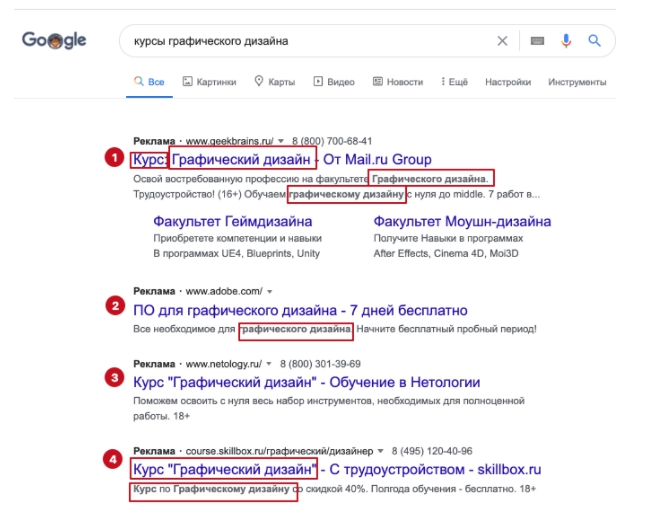
The screenshot above shows that only 1 and 4 advertisers still fool around with writing keywords in the descriptions, and not just in the titles. I will assume that they pay the rate correspondingly less than the rest.
Please note that 1 advertiser has entered the keyword as many times as possible. 2 will unfortunately pay the highest price since he sells software but not courses.
2. Flexible bid management
Let’s be honest, there are few keywords for which the level of competition is minimal. Let’s take the same graphic design:

In the screenshot, using Keyword Planner, we can see the level of semantic competition.
And that means one thing – we need more control over how we manage our bids. Otherwise, the drain of money is guaranteed.
By assigning bids correctly based on our site conversion, and marginality and CPC, we will be able to receive profitable traffic. How to calculate the maximum cost per click is on our YouTube channel.
And in some niches, CPC goes up to $10 and up.
3. Easy to train the system and learn yourself
The structure of one group – 1 keyword is as simple and effective as possible. It’s easy to do, you can quickly create thousands of ads quickly.
If the group gets enough statistics, then you can add automatic strategies and be 100% sure that they will work to the maximum.
Disadvantages of single-keyword ad groups:
- Manually creating such advertising campaigns takes a lot of time (unless you automate part of the routine)
- Some specialists are too time-consuming to maintain
- Slowly testing new versions of changes or experiments.
- Reducing the optimization score due to the fact that there are too few requests for low-frequency keywords. And you need to fight with the optimization indicator. Otherwise, Google will underestimate the ratings. Do we need it?
- Manually, creating such advertising campaigns takes a lot of time (only if you automate part of the routine)
If you add thousands of keywords to your account instead of 20, then for many this is a difficult piece of work.
Not only do you need to correctly group your ad campaigns, but you also need to create at least 3 ads per group.
Recommendation for pedants: if you want to work with the SKAG structure, get Excel and a couple of macros, or at worst, entrust the routine work to a freelancer and breathe easy 🙂
1. For some specialists, it is too laborious to accompany
It’s hard to keep track of all the search queries, the performance of each of the ads, edit the CTP and ads.
But I think the problem here is not that anymore, but that specialists cannot manage large volumes of keywords. I “survived” the fashion for millionaire accounts in both Yandex Direct and Google advertising, so for me such structures are as streamlined as possible and as fast as possible to manage. But for some, it will be a data array in which it will be lost like a needle in a haystack.
2. Slowly testing new versions of changes or experiments.
For example, we conduct a/b testing of new ad variations. Of course, on a keyword that has 20 impressions per month, you can wait six months to understand which ad should be removed now.
For pedants: I wouldn’t focus on doing a quick A/B test. Your task is not a/b testing, your task is to get traffic at the best possible price. If your keyword is written as much as possible in the ad, then the prefix with a promotion or price will wait for a sufficient number of clicks.
3. Reduced optimization score due to the fact that there are too few requests for low-frequency keywords.
We all know that the optimization score, namely its increase towards 100%, affects the overall ad rating in the account. And it is worth considering. In addition, Google often writes:
Keywords tagged “Low search volume” are associated with very little search traffic on Google, indicating that they are not very relevant to the queries of most customers. For this reason, Google temporarily disables these keywords to prevent them from triggering your ads.
And this means that it will intentionally limit our keys in impressions, whether we like it or not.
Why is he doing this? To reduce the work of system resources for moderation, settlements and other things.
Will single-keyword ad groups be relevant in 2020?
The SKAG structure has received very wide popularity and popularity and has been working out with a bang so far.
How many calls and sales will I get by ordering contextual advertising from you?
I need to calculate the conversion of my website Describe
the task
in the application
Calculate potential ad revenue Google
contextual advertising calculator
And I love her dearly, as before.
I consider it one of the ideal ways to structure your Google Ads account.
But Google has made so many changes in the last 2 years (and many more to come) that it needs to be adjusted and adjusted to the new conditions.
Back in 2014, Google updated its rules on close variations. Remember the designer and design? These are flowers…
And in today’s competitive environment, it is important to control any spending of money and not drain traffic to what Google seems close to, but in fact far from business processes.
In 2017, we made changes to the exact match type. https://adwords.googleblog.com/2017 /03/close-variants-now-connects-more-people.html
Namely, they added keyword reordering functionality and the ability to add new wording.
Yes, apartments and interiors are close options.
2019: synonyms and intents combined into phrase and modified broad match
In short, Google wants to increase its revenue, don’t think it’s done to improve your Google Ads experience. This makes Google a favorite to get even more billions in your bank account 🙂
But, all the mixing, synonyms, and so on can be solved with the right cross-backing track. But in 2019, I encountered another problem – this is that the cross-backing track no longer works as it was originally. Often, it limits clicks and impressions a priori. More precisely, on search queries, where there are about 50 impressions per month, it limits impressions too much. Moreover, Google reduces my impressions due to the fact that my keywords do not have a very high frequency (remember, I wrote above).
Problems with the distribution of the budget. Google is more willing to allocate budget and impressions to higher keywords.
In this regard, I came to the conclusion that it is necessary to structure the keywords differently.
I ended up with the following structure:
Intent Keyword Ad group (IKAG). Haven’t come up with a simpler name yet. This is grouping by user intent.
Yeah, that’s what I say in every one of my videos, you have to tailor your keyword to the sales funnel.
The main task is not to get the maximum clicks, but to focus on what the client is really looking for. That is, we will structure all the semantics with you according to the user’s intention. And for this, we will have to stretch our brains a little.
Why by “intention”? Because there is no more semantics left in the world where there is low competition. Even Google itself limits us in this. Therefore, it is better to understand how our client thinks, adjust advertising at the most opportune moment and catch the client like a fisherman on a bait. Yes, I compare search ads to ocean tuna fishing. Here you need experience, dexterity and attentiveness. This is not for you to walk on the Azov bull with a net 🙂
All advertising must be tailored to the client’s avatars. Therefore, we draw up portraits of the target audience, analyze them and build them:
GOOGLE AD SALES FUNNEL
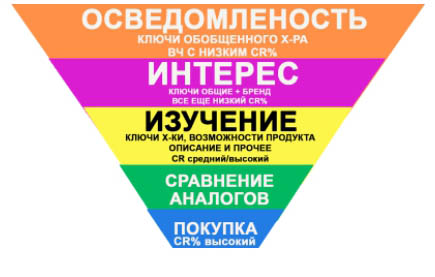
What would we take as an example of parsing this intent funnel?
Take the same query “buy shrimp”. Shrimps are different: frozen, boiled, fried, dried, plastic, tiger, etc. That is, upon request, we do not understand the final intention: what product and at what cost a person is ready to buy.
If we sell tiger prawns, then our keywords are: “buy tiger prawns with delivery”, “tiger prawns with delivery” and so on.
Or, for example, selling the same tuna fillet. Let’s say we want to sell a fillet to a person who likes to cook at home. For example, this MCH is 25-45 years old, he likes to relax at home in the countryside. He has a barbecue and likes to please his friends and himself with something unusual.
AWARENESS stage:
What could be the queries here? There is usually something HF. For example, “tuna”,

Next stage of interest:
Here there may be keywords related to the study of the beneficial properties of “healthy properties of tuna”

or recipes:
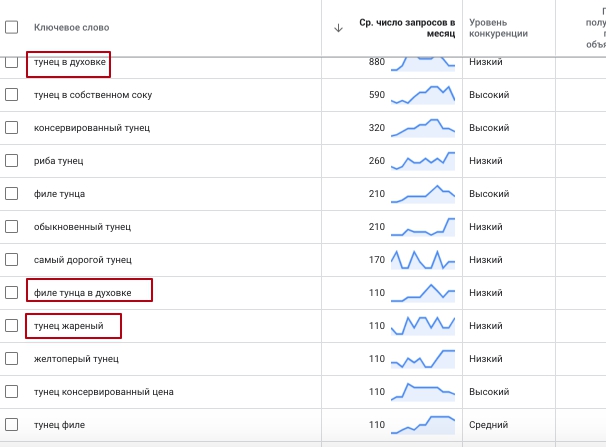
I understand that the frequency is not very presentable, but tuna is not an iPhone, not everyone buys it :).
At the stage of reviewing the recipes, he already realized that he needed to be more careful in choosing the fillet itself, that there are varieties of tuna and they differ in taste.
So, we are moving on to the learning stage:
“tuna for sushi” is one of those queries that can tell us that it will be a high quality product.
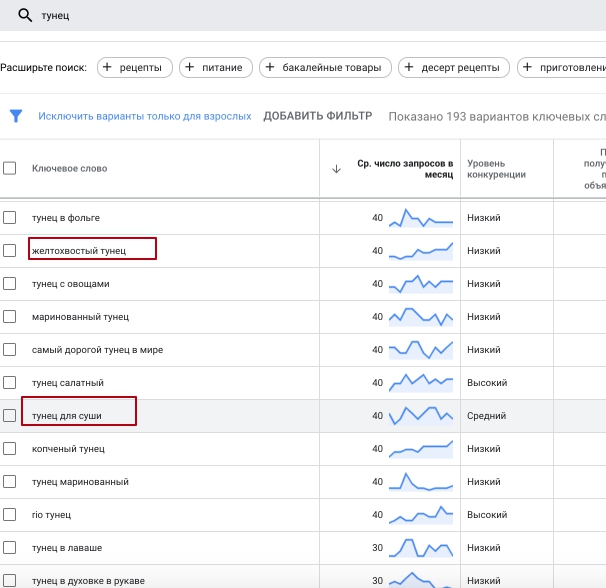
Next, we proceed to the stage of comparing analogues:
Here a person will already look for where to buy and compare options, so the phrases are the scene:
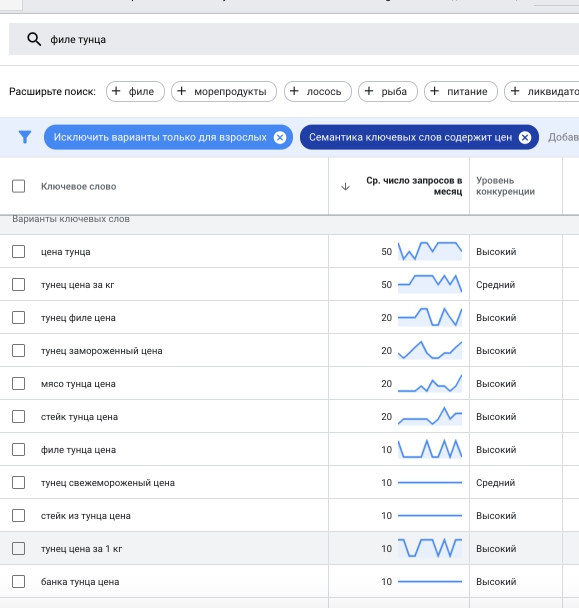
At this stage, a person studies prices, delivery options, and more.
And the final chord:
This is a tuna fillet with delivery.
Here is a description of the user’s intent.
So you need to focus on the user’s intent, not the type of key, cold, warm, high or low.
If a person enters a query, “design trends”, then this query responds to the fact that the user has just begun to study design, and the key “design courses price” means that the user compares prices and thinks who to buy from .
How to structure them later?
If we have multiple keyword groups:
- price/cost requests
- requests with geo
- requests with buy/order
- brand + model queries
- requests inexpensive/cheap/available
In principle, this is your grouping within the same product / service.
By selecting keywords with queries closest to the user’s wallet, there is a greater chance of converting into a sale. Collecting general traffic, it would seem even targeted, is too costly both in terms of time and finances for advertising.
After we have collected the keywords, we need to group them, and this can also help us intention and similarity between keywords.
On the one hand, the similarity between keywords will allow us to group similar keys (for example, price), on the other hand, we will be able to write the most relevant ad in which we will give an answer to the user’s intention and as a result we get a sale.
In principle, everything, The same principle applies to services, B2C, B2B and others.
Need to reveal more? Write and I will do it!






